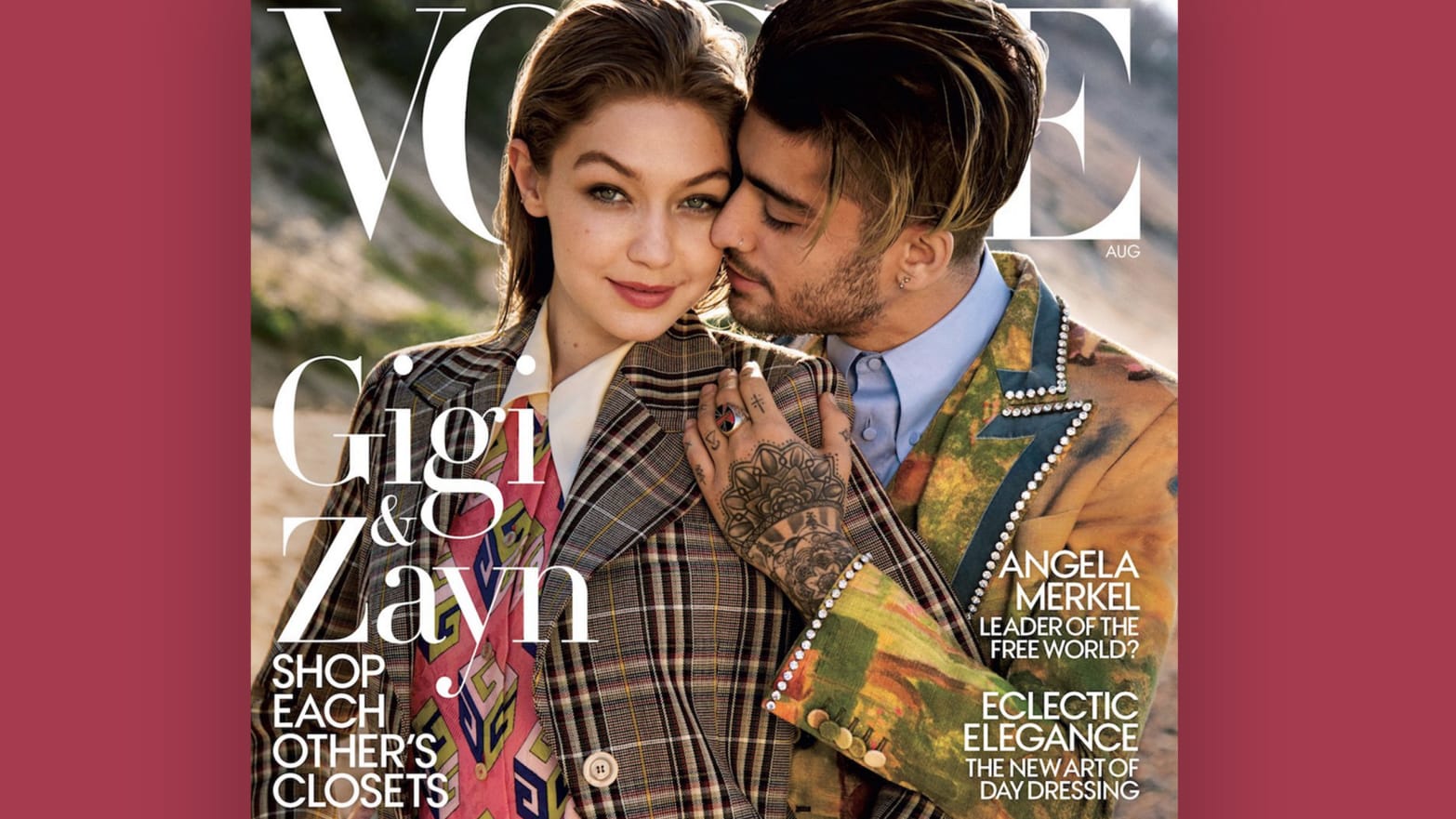There are certain things that media vultures live for. When Lena Dunham missteps. When The New York Times Style section remembers Brooklyn exists (or, more recently, when one of its columnists learns that a college degree is not a prerequisite for enjoying deli meats). And, in that same vein, when Vogue embarrasses itself.
It’s become a digital age truth that Vogue, once the venerable arbiter of forthcoming trends and the progressive future, is now the publication most likely to be playing catch-up when it comes to being “woke” in today’s culture. Case in point: this week’s style story shaming men who carry tote bags because they look “like a ninny.”
Gender norms are at the center of the fashion mag’s latest controversy, with an obtuse cover featuring real-life couple and extremely attractive young millennials Gigi Hadid and Zayn Malik, celebrating the duo for being “part of a new generation embracing gender fluidity.”
One can imagine the pitch meeting where a young editor mentioned gender fluidity and some higher up, recognizing it as a buzzword, commissioned a piece which, in an attempt to explain it to Vogue readers, tells a story about how Hadid sometimes wears Malik’s clothes. Even though she’s a girl and he’s a boy! And, once in a while, vice versa!!!
The silent screams of every LGBTQ activist and expert are harmonizing in chorus to create that faint siren you hear right now, all over the idea that whether an $800 designer tee was meant for a male famous person or a female famous person explains gender fluidity. Certainly it has nothing to do with the danger, judgement, and societal shaming facing actual gender fluid citizens each and every day in our society.
Vogue is confusing an existence for a trend.
The story mentions the high-fashion trailblazer of gender fluidity—at least when it comes to how fancy rich people choose to dress (though certainly not when it comes to the fight and grit it takes to be gender fluid in a still-skeptical society)—Jaden Smith, who made a stir for wearing skirts last year and recently starred in a Louis Vuitton womenswear campaign.
Androgynous Chinese pop star Chris Lee also gets mentioned, alongside the question, “Where exactly, is someone neither entirely he nor she meant to shop? And how, exactly, is such a person to be defined?”
They don’t want to be defined! That’s the crux of the article, which mentions that celebrities like Evan Rachel Wood are wearing pantsuits on red carpets, Pharrell Williams wears a necklace, and some designers are even showing their male and female collections together, suggesting a hipness of androgynous fashion that would be revolutionary, had it not been en vogue (heh) in the punk-rock ‘90s, the glam rock ‘80s, and, hell, the entire history of fashion.
For proof these millennials don’t give a damn about your old fogey words like “boy” or “girl,” it mentions the fact that Hadid and Malik were wearing gender non-specific track suits (as opposed to all those sweatpants that are aggressively gendered) and provides a quote from Hadid about how she picks out clothes from boyfriend Malik’s closet all the time.
Then there was this exchange, which I will cut out of the magazine and hand to my doctor when he asks why my blood pressure is suddenly so dangerously high:
“Yeah, but same,” replies Malik, 24. “What was that T-shirt I borrowed the other day?”
“The Anna Sui?” asks Hadid.
“Yeah,” Malik says. “I like that shirt. And if it’s tight on me, so what? It doesn’t matter if it was made for a girl.”
Hadid nods vigorously. “Totally. It’s not about gender. It’s about, like, shapes. And what feels good on you that day. And anyway, it’s fun to experiment. . . .”
The internet is rightfully dragging Vogue for portraying a still-vulnerable identity struggling for cultural validation as a “kids these days!” carefree phase.
Our favorite tweet suggests that Vogue’s sister (daughter?) publication, the inaugural Pulitzer Prize of Wokeness winner Teen Vogue needs to have a word with its mothership.
God bless Marc Jacobs (always, but especially now), for showing up late in the piece as a voice of reason. Well, reason-ish.
“These kids—I’m not sure they’re any different from the people I saw at Danceteria or Mudd Club in the eighties,” he said. “The difference is that back then, the expression—extreme looks, cross-dressing, what have you—was hidden away in a speakeasy or a club. Today, thanks to the internet, that culture is widely exposed.”
It’s certainly exposed within the realm of celebrity and teen culture as it exists on Planet Fashion and to be covered fawningly in the pages of Vogue. But when one wants to have a serious conversation about what it means to identify as gender fluid in 2017, suffice it to say the first thought isn’t the plight of explicitly cisgender and gender-conforming famous people Gigi Hadid and Zayn Malik.
There’s a spate of celebrities “embracing gender fluidity” that seems to exist on a spectrum of fully identifying that way (Billions star Asia Kate Dillon, for example) and commoditizing the idea of wokeness for attention (a Miley Cyrus or Ruby Rose)—a jaded reading of the trend, but, in the world of the celebrity rat race, undeniably true.
There has been an evolution when it comes to gender identity in the current younger generation, but Hadid and Malik aren’t the faces of that generation. It is the people risking their lives to redefine the idea of gender expression and identity in communities that do not understand it, in institutions that do not welcome it, and culture that stigmatizes it.
It is the population of people who are affected by every development in the spate of bathroom bills being legislated around the country, are triggered by the bureaucratic requirement to often have to self-identify as male or female even if they don’t express in those binaries, and, on a simple fashion level, aren’t celebrated in the pages of Vogue for being a male who wears a skirt, but instead beat up for it.
Zayn and Hadid are very rich and privileged people who sleep lightly on their goose-feather pillows feeling enlightened because they gave an interview about sharing clothes, but who are clearly clueless about the LGBT people, politics, and history that made their $1,000 gender-fluid shirt swapping possible.
On the one hand, it’s admirable that a publication like Vogue tackles this issue at all and brings the idea of gender fluidity to an affluent and influential audience. But how about it marry its power with its ensuing responsibility, and use its pages to more seriously and accurately discuss the nuances of these LGBT issues and the prejudice that follows them rather than exalt celebrities for their witless musings on coats?
Quoth Ms. Priestly: that’s all.
Update July 14, 4:35 pm ET: A Vogue spokesperson sent this statement to The Daily Beast: “The story was intended to highlight the impact the gender-fluid, non-binary communities have had on fashion and culture. We are very sorry the story did not correctly reflect that spirit – we missed the mark. We do look forward to continuing the conversation with greater sensitivity."

